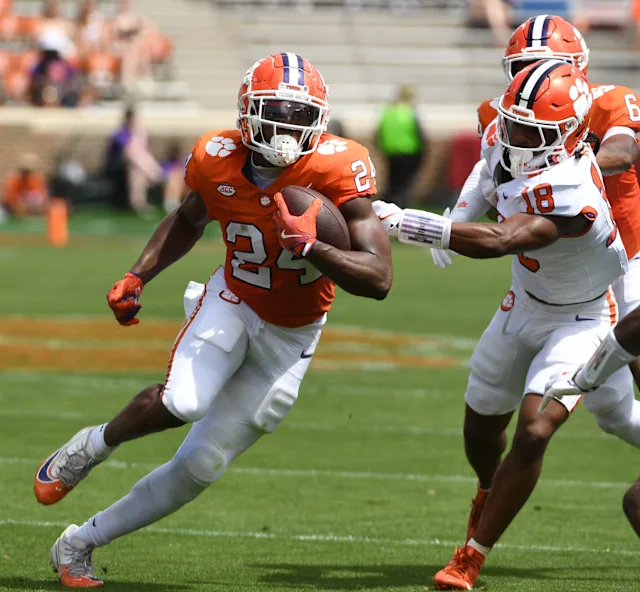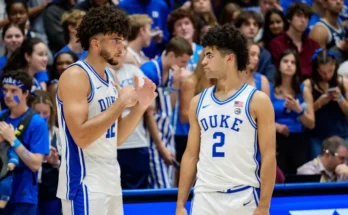Clemson Football Coach Recognizes Issues with Running Back Depth
Clemson University has long been a powerhouse in college football, with its elite programs consistently competing at the highest levels in both the Atlantic Coast Conference (ACC) and nationally. The Tigers have produced countless NFL-caliber athletes, from wide receivers to quarterbacks to defensive players, and one of the most notable positions of focus has always been running back. The running back position has been integral to Clemson’s offensive identity, and over the years, the team has been home to some of the most dynamic and explosive players in college football.
However, as the 2025 season approaches, Clemson’s football coach has expressed growing concern over the team’s depth at the running back position. With the departure of key players, the ongoing search for capable replacements, and the increasing pressures of maintaining a championship-caliber roster, the running back position has emerged as a potential weakness for the Tigers. This article aims to delve deeply into the situation surrounding Clemson’s running back depth, the factors contributing to the current state of the position, the potential impact on the team, and what the future holds for the Tigers as they navigate this uncertainty.
### The Significance of the Running Back Position at Clemson
Clemson’s football program has a long history of excellence at the running back position. From early greats like C.J. Spiller, who electrified fans with his speed and playmaking ability, to recent stars such as Travis Etienne, who redefined the role with his combination of speed, vision, and power, the running back has always been a cornerstone of the Tigers’ offensive strategy. The program has a reputation for producing well-rounded backs who can contribute in multiple ways—whether that’s through ground-and-pound running, catching passes out of the backfield, or even serving as a dynamic option in special teams play.
Running back production has been one of the major factors in Clemson’s success over the past decade. The team’s ability to maintain a potent rushing attack has been critical in keeping opposing defenses on their toes, complementing their high-powered passing game, and providing balance to their offense. This balance has allowed Clemson to stay competitive in the ACC, and it has played a pivotal role in their multiple playoff appearances and national championships.
As such, any threat to the running back depth is a concern that Clemson’s coaching staff cannot afford to ignore. Losing or failing to develop quality running backs has the potential to disrupt the entire offensive flow and may lead to a loss of balance in an otherwise potent offensive scheme.
### The Current State of Clemson’s Running Back Room
Heading into the 2025 season, Clemson’s running back depth has been a topic of significant concern. While the program has produced outstanding running backs in recent years, the departure of players like Travis Etienne—who left for the NFL after a stellar career—has left a noticeable void. Clemson has not yet managed to replace him with a comparable level of talent, which has led to uncertainties about the team’s ability to field a reliable and explosive rushing attack.
This situation has left the Tigers with a mix of unproven talent, some experienced players, and a few highly touted recruits. But while the talent may be there in theory, the lack of proven success at the collegiate level is where the issue lies.
### Departure of Key Players and Gaps in the Depth Chart
One of the most immediate factors contributing to the current state of the running back position is the departure of key players over the last few seasons. Notably, Travis Etienne’s graduation has left a massive gap in the team’s backfield. Etienne was not only one of the best running backs in Clemson history but also one of the most dominant players in college football during his tenure with the Tigers. His ability to break off long runs, make defenders miss in space, and contribute as a receiver out of the backfield was unmatched. With his departure, Clemson is left trying to find a running back who can replicate that level of performance.
Additionally, while other talented players have entered the program over the years, many of them have either not lived up to expectations or have struggled with consistency. There has been a lack of continuity at the running back position, making it difficult for the Tigers to establish a reliable backfield rotation.
One of the primary challenges Clemson faces is the absence of an established star who can take over the feature back role. Coaches rely on their running backs to handle a heavy workload, especially in crucial games, and the absence of a proven commodity creates uncertainty. For a program like Clemson, which thrives on a powerful and efficient offense, not having a standout running back could lead to struggles in executing a balanced attack.
### Recruiting and Development of New Talent
In response to the running back concerns, Clemson has turned to its recruiting efforts to bolster the position. The team has signed several promising running back prospects in recent years, some of whom are expected to develop into the next great stars in the program’s history. Yet, recruiting top-tier running backs doesn’t always guarantee immediate results. The transition from high school to college football is often a difficult one, particularly for running backs who must adjust to the speed, physicality, and complexity of college-level defenses.
Clemson’s coaching staff has been known for their ability to develop talent, but running backs require time and experience to truly blossom into high-level contributors. The program may need to take a more patient approach in allowing its young running backs to develop, while also providing them with adequate opportunities to gain in-game experience.
While Clemson’s coaches have been successful in recruiting elite talent at virtually every position, it remains to be seen whether the team’s current crop of running backs can step up to the challenge. The stakes are high for these young athletes, as they must prove themselves capable of playing at an elite level in the competitive landscape of college football.
### The Impact on Offensive Strategy
Clemson’s offense has traditionally been known for its explosive, high-scoring style of play. A strong running game has always been a foundational element of that strategy. However, with the current uncertainty surrounding the running back position, there is concern that the Tigers may be forced to alter their offensive approach.
Without a proven feature back, Clemson may have to rely more heavily on the passing game and its star quarterback, assuming he can handle the increased responsibility. While the Tigers have certainly excelled in the passing game, with talented receivers and a dynamic quarterback, an offense that is too one-dimensional is easier for opposing defenses to predict and prepare for.
Moreover, the lack of a strong running game could lead to more predictable play-calling and result in fewer opportunities for explosive plays, which could ultimately hinder the team’s overall offensive efficiency. A balanced attack is essential for keeping defenses off balance, and without a capable running back rotation, Clemson’s ability to execute its full offensive playbook could be compromised.
### Potential Solutions and Strategic Adjustments
There are several potential solutions that Clemson’s coaching staff could explore as they look to address their running back concerns. First and foremost, the coaching staff may need to give more responsibility to their young players, allowing them to gain the experience necessary to develop into future contributors. By getting their young backs significant playing time early in the season, the staff can assess their potential and better understand how they can contribute to the team’s success.
Additionally, Clemson may look to adjust its offensive philosophy. While a powerful running game has been a staple of the Tigers’ offense, the team could emphasize a more pass-heavy attack, especially if the running backs are not yet fully developed. This would allow the team to rely on its proven strength—its passing game—while also giving its running backs time to mature. The coaching staff may also look to employ a more committee-based approach, rotating several backs into the game to keep defenses guessing and reduce the wear-and-tear on individual players.
Another potential solution is to adjust recruiting strategies to bring in more high-caliber running backs, whether through the high school ranks or the transfer portal. The transfer portal has become a crucial tool for many college football programs, allowing them to address roster needs in a more immediate fashion. If Clemson cannot find a long-term solution within its current roster, it may turn to the transfer market for a veteran presence who can provide stability to the running back room.
Clemson’s football program is undoubtedly one of the elite teams in college football, and its track record of success has made it a perennial contender. However, the Tigers’ running back depth is a real concern as the 2025 season looms. With the departure of key players and the development of new talent still a work in progress, Clemson faces the difficult task of finding the right balance in its backfield.
The coaching staff must continue to recruit at a high level, develop young talent, and potentially adjust their offensive strategy to compensate for the uncertainty at the running back position. While Clemson’s passing game remains a strength, it cannot afford to ignore the importance of a strong, dynamic rushing attack. As the Tigers move forward, they will need to address these concerns in order to maintain their standing as one of college football’s elite programs and continue their quest for national championships.



